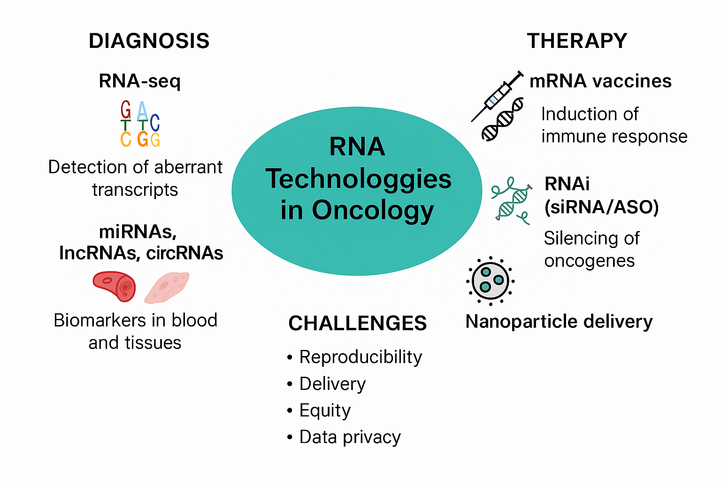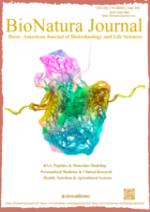RNA Technologies in Cancer Care: Bridging Promise and Practice
ABSTRACT
RNA technologies are rapidly reshaping cancer diagnostics and therapeutics, offering unprecedented promise alongside persistent challenges. This News and Views synthesizes evidence from meta-analyses and systematic reviews on RNA sequencing (RNA-seq), non-coding RNAs, and RNA-based therapies. We highlight advances in personalized diagnostics, mRNA vaccines, and RNA interference (RNAi), while addressing technical, clinical, and ethical barriers to clinical adoption. A balanced perspective is essential as the field advances toward precision oncology.
Keywords: RNA-seq; non-coding RNAs; mRNA vaccines; precision oncology; RNA interference; biomarkers; nanodelivery; medical ethics.
INTRODUCTION
Revolutionizing Diagnostics
RNA-seq has emerged as a cornerstone of cancer diagnostics, enabling detection of gene fusions, aberrant transcripts, and extracellular RNAs (eRNAs) with high throughput and quantitative precision¹⁻⁴. A 2020 meta-analysis by Buzdin et al.² demonstrated its utility in guiding therapy for refractory tumors, while Sempere et al.⁷ validated miRNA signatures for subtype stratification and prognosis. Non-coding RNAs (miRNAs, lncRNAs, circRNAs) are increasingly recognized for their diagnostic potential due to tissue specificity and stability⁵⁻⁷.
Transforming Therapeutics
The mRNA vaccine platform, accelerated by COVID-19 research, now shows promise in oncology, with early trials reporting immune responses in immunogenic tumors⁸. RNAi tools (siRNAs, antisense oligonucleotides) coupled with nanoparticle delivery systems (e.g., lipid nanoparticles) offer targeted gene silencing but face challenges like hepatotoxicity³.¹⁰.
Persistent Challenges
Technical and Biological Hurdles
· Reproducibility: Only 40% of RNA-seq assays meet clinical-grade standards due to protocol variability¹.
· Delivery: Nanoparticles improve cellular uptake but may trigger immune reactions³.¹⁰.
· Functional ambiguity: circRNAs and lncRNAs lack full mechanistic understanding⁵.⁶.
Ethical and Equity Considerations
· Access disparities: Less than 3% of RNA therapy trials include low-income regions¹⁰.
· Data privacy: Transcriptomic data requires robust governance to protect patient identity¹¹.
Meta-Evidence Synthesis (Table 1)

Table 1. Summary of key findings from recent studies on RNA technologies in oncology. This table synthesizes results from meta-analyses and systematic reviews evaluating the clinical impact of different RNA types, such as mRNA and miRNA. Highlighted applications include diagnostics and therapeutics, along with major limitations such as lack of standardization, need for larger validation cohorts, and challenges in delivery and clinical implementation.
Future Directions
1. Integration: Combine RNA-seq with genomic profiling for comprehensive tumor analysis¹⁻⁴.
2. Equity: Expand trial access to underrepresented regions¹⁰.
3. Ethics: Develop frameworks for data sharing and patient consent11,12.
"The translation of RNA technologies must balance innovation with inclusivity and rigor."
As RNA technologies continue to redefine cancer diagnostics and therapeutics, their successful integration into clinical practice will depend not only on scientific innovation, but also on our collective ability to navigate the ethical, logistical, and societal dimensions they entail. The future of precision oncology lies in interdisciplinary collaboration—where molecular insights, equitable access, and patient-centered values converge. Embracing this complexity with critical optimism will be key to translating RNA promise into lasting clinical progress.

Figure 1. Overview of RNA technologies in cancer care, highlighting their roles in diagnosis and therapy, along with key implementation challenges. Diagnostic tools include RNA-seq and non-coding RNAs (miRNAs, lncRNAs, circRNAs), while therapeutic approaches feature mRNA vaccines and RNA interference. Nanoparticle delivery systems enhance RNA-based interventions but raise technical and safety concerns. Persistent challenges include reproducibility, delivery optimization, data privacy, and equitable access.
CONCLUSIONS
RNA technologies are poised to become central pillars of cancer diagnostics and therapeutics. The clinical promise is substantial, with the potential to improve early detection, guide therapy selection, and enhance patient outcomes. Yet realizing this promise requires coordinated efforts to overcome technical, biological, and ethical hurdles.
Meta-analyses and systematic reviews provide a roadmap for future research, illuminating areas of strength and identifying gaps that must be addressed. A balanced perspective—critical and hopeful—will be essential as the field advances. Integrating RNA technologies into oncology can transform cancer care, but that transformation must be guided by scientific rigor, ethical foresight, and a commitment to equitable, patient-centered outcomes.
Author Note
This News and Views piece reflects the author's independent perspective and synthesis based on current literature. No specific funding supported the preparation of this article.
Conflict of Interest Statement
The author declares no conflict of interest.
REFERENCES
1. Byron SA, Van Keuren-Jensen KR, Engelthaler DM, Carpten JD, Craig DW. Translating RNA sequencing into clinical diagnostics: opportunities and challenges. Nat Rev Genet. 2016;17(5):257-269. doi:10.1038/nrg.2016.10.
2. Buzdin A, Sorokin M, Garazha A, et al. RNA sequencing for research and diagnostics in clinical oncology. Semin Cancer Biol. 2020;60:311-323. doi:10.1016/j.semcancer.2019.07.010.
3. Hong M, Tao S, Zhang L, et al. RNA sequencing: new technologies and applications in cancer research. J Hematol Oncol. 2020;13:166. doi:10.1186/s13045-020-01005-x.
4. Wang H, Meng Q, Qian J, et al. RNA-based diagnostic markers discovery and therapeutic targets development in cancer. Pharmacol Ther. 2022;239:108123. doi:10.1016/j.pharmthera.2022.108123.
5. Kristensen LS, Hansen TB, Venø MT, Kjems J. Circular RNAs in cancer: opportunities and challenges in the field. Oncogene. 2017;37:555-565. doi:10.1038/onc.2017.361.
6. Tortora F, La Civita E, Trivedi P, et al. Emerging RNA-Based Therapeutic and Diagnostic Options: Recent Advances and Future Challenges in Genitourinary Cancers. Int J Mol Sci. 2023;24(5):4601. doi:10.3390/ijms24054601.
7. Sempere LF, Azmi AS, Moore A. microRNA-based diagnostic and therapeutic applications in cancer medicine. Wiley Interdiscip Rev RNA. 2021;12(2):e1662. doi:10.1002/wrna.1662.
8. Liu C, Shi Q, Huang X, et al. mRNA-based cancer therapeutics. Nat Rev Cancer. 2023;23:241-258. doi:10.1038/s41568-023-00586-2.
9. Eralp Y. Application of mRNA Technology in Cancer Therapeutics. Vaccines (Basel). 2022;10(8):1262. doi:10.3390/vaccines10081262.
10. Attia MF, Kijanka G, Nguyen NL, et al. Advances and prospects of RNA delivery nanoplatforms for cancer therapy. Acta Pharm Sin B. 2024;15(3):456-472. doi:10.1016/j.apsb.2024.09.009.
11. Chu LH, Joly Y, Knoppers BM. Equity in access to gene and RNA therapies: mapping clinical trial inclusion. Sci Transl Med. 2023;15(719):eadd1902. doi:10.1126/scitranslmed.add1902.
12. Zavala VA, Kalinowski A, Sanchez HN, et al. Ethical considerations for sharing transcriptomic data in cancer research. EXCLI J. 2021;20:1331-1336. doi:10.17179/excli2021-3833.
Received: March 20, 2025 / Accepted: May 8, 2025 / Published: June 15, 2025
Citation: Fernández Maso JR. RNA technologies in cancer care: bridging promise and practiceBionatura Journal. 2025;2(2):15. doi:10.70099/BJ/2025.02.02.15
Peer Review Information:
Bionatura Journal thanks the anonymous reviewers for their valuable contribution to the peer review process of this work, supported via https://reviewerlocator.webofscience.com/
Bionatura Journal thanks the anonymous reviewers for their valuable contribution to the peer review process of this work, supported via https://reviewerlocator.webofscience.com/
ISSN: 3020-7886
Publisher's Note:
Bionatura Journal remains neutral with regard to jurisdictional claims in published maps and institutional affiliations.
Bionatura Journal remains neutral with regard to jurisdictional claims in published maps and institutional affiliations.
Copyright:
© 2025 by the authors. This article is published under the terms of the Creative Commons Attribution License (CC BY 4.0), which permits unrestricted use, distribution, and reproduction in any medium, provided the original work is properly cited. For more information, visit: https://creativecommons.org/licenses/by/4.0/
© 2025 by the authors. This article is published under the terms of the Creative Commons Attribution License (CC BY 4.0), which permits unrestricted use, distribution, and reproduction in any medium, provided the original work is properly cited. For more information, visit: https://creativecommons.org/licenses/by/4.0/
Copyright: © 2025 by the authors. They were submitted for possible open-access publication under the terms and conditions of the Creative Commons Attribution (CC BY) license (https://creativecommons.org/licenses/by/4.0/).
How to cite this article:
Fernández Maso J.R. RNA Technologies in Cancer Care: Bridging Promise and Practice. BioNatura Journal. 2025; 2(2):15. DOI: 10.70099/BJ/2025.02.02.15



